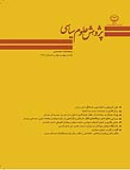بررسی مقایسهای دیدگاههای هگل، مارکس و گرامشی درباره دولت و جامعه مدنی
محورهای موضوعی : پژوهش سیاست نظری
1 -
کلید واژه: جامعه مدنی جامعه سیاسی جامعه بورژوازی خانواده دولت دولتشهر,
چکیده مقاله :
هدف این مقاله بررسی مقایسهای آراي سه تن از نظریهپردازان تضادگرا، یعنی هگل، مارکس و گرامشی در باره دولت و جامعه مدنی و مناسبات بین آن دو است. هگل جامعه مدنی را به منزله ترکیبی از سه نظام اقتصادی، حقوقی و انسجامی (پلیس و اصناف) قلمداد میکرد که بین خانواده و دولت قرار میگیرد و در نهایت، جانشین دولت میشود و مارکس از جامعه مدنی به عنوان حوزه کار و زندگی روزمره که حوزهای صرفاً اقتصادی و غیرسیاسی است، نام میبرد. بر خلاف هگل و مارکس، گرامشی جامعه مدنی را به مثابه فضایی فرهنگی قلمداد میکند. نتیجه این تحلیل نظری ـ تطبیقی نشان میدهد هر چند هر سه نظریهپرداز تضادی اصول فلسفه هر چند اجتماعی مشترکی را پایههای تحلیل خود قرار دادهاند، نتیجهگیری آنها از الگوسازی جامعه با یکدیگر فرق دارد. هگل طرح سه وجهی خانواده ـ جامعه مدنی ـ دولت را جانشین طرح کلاسیک دو وجهی خانواده ـ دولتشهر ارسطو نمود. همچنین الگوي مارکسیستی زیربنا (جامعه مدنی) و روبنا (دولت)، در نزد گرامشی به الگوي زیربنا (اقتصاد) و روبنا (جامعه مدنی ـ نهادهای غیردولتی + دولت) تغییر پیدا کرد. دولت گرامشی یک دولت ترکیبی است که از رضایت (سلطه) + زور (قدرت) تشکیل شده است و از این رو، هم زیربنایی است و هم روبنایی.
The purpose of this article is the comparative survey of three contrastive theoreticians- Hegel, Marx, and Gramsci- on state, civil society and their relationships. Hegel assumed the civil society as a combination of three systems; the economical, legal and cohesive (police and their related classes) which stand between the family and the state; which ultimately substitutes the state. Marx considers the civil society as the domain of work and everyday life, which is a totally economical and apolitical domain. Unlike Hegel and Marx, Gramci observes the civil society as a cultural sphere. The result of this theoretical comparative analysis shows that although these three contrasting theorists of philosophical principles assume a similar and common society as the base of their analysis, their conclusions on the society’s pattern structure differs with each other. Hegel substituted the three-dimensioned pattern of “family-civil society-state” with Aristotle’s classic two-dimensioned pattern of “family-city state”. Also Marx’s substructure pattern (on civil society) and superstructure (state) changed for Gramsci to the substructure (economic) and superstructure (civil society = nongovernmental organs + state). Gramci’s state is a combinative state compiled of the satisfaction of “mastery + power” and therefore it is both the substructure and the superstructure.


